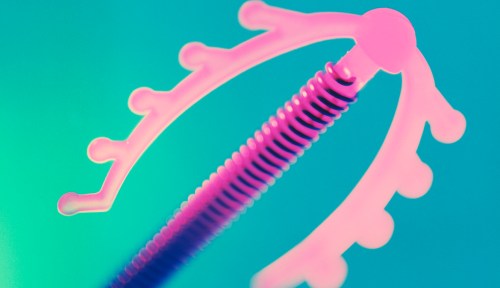Getting an IUD Can Really F*cking Hurt—and the CDC Is Finally Paying Attention
Women's health care providers explain what causes IUD insertion pain, why it's often minimized or dismissed, and the pain-relief options.

On Tuesday, for the first time ever, the Centers for Disease Control and Prevention (CDC) updated its guidance regarding IUD insertion, advising doctors to discuss pain-management options with patients before the procedure.
Experts in This Article
certified family nurse practitioner and chief clinical officer at Tia
board-certified urogynecologist and OB/GYN
board-certified OB/GYN
IUDs, or intrauterine devices (a popular form of birth control), have been around for decades, but this is the first time federal health officials have acknowledged the pain that can come with IUD insertion and offered guidelines for health care professionals around mitigating it. Ideally, according to experts interviewed by The New York Times, the advice will encourage doctors to both take the pain more seriously and use pain-relief options like anesthetics more often.
The update comes amid scores of TikTok videos posted by women meant to shed light on the gaslighting they often face in regard to IUD insertion pain. (And because about 20 percent of women rely on an IUD for birth control, it’s no wonder there are so many accounts out there.)
“I remember I was told that I should take some painkillers because there was going to be a little bit of pain during the procedure,” TikToker @janicea312 shared in a viral reel. “Moments before it was implanted, I was told I was going to experience some pressure. It wasn’t pressure, it was f**king painful.”
But why are reactions to a procedure with a history dating back to 1909only now garnering online attention (and action from the CDC), and why has the medical community historically downplayed the associated pain?
First: Why *is* IUD insertion so painful?
Having personally undergone both the insertion and removal of an IUD, I can assure you that the experience of having it inserted and taken out was far more painful than “just a bit of pressure.” Although my doctor informed me that I might have some brief discomfort, I was led to believe it wouldn’t hurt. Spoiler alert: It did.
While I’m certainly not alone in that, it’s important to note here that not everyone has a painful experience. Indeed, Kameelah Phillips, MD, a board-certified OB/GYN and Organon health partner, warns that social media isn’t a balanced representation here. “Most of the time, the negative experiences are what rises to the top,” she notes, and people are less likely to make a reel about a positive experience.
“Every woman’s body can have unique nuances in terms of anatomy,” says Jessica Horwitz, MPH, FNP-C, chief clinical officer at Tia, a women’s health clinic, noting that a history of vaginal delivery and individual pain tolerance levels can also come into play. “Thus, the way women experience pain during an IUD insertion can vary across the spectrum.”
To understand why the procedure can be painful (to the point where some people say they deserve a gift from their partner for going through it), we need to understand how an IUD is inserted. First, a tool called a speculum is put into the vagina to hold it open, allowing the health care provider to see the cervix (the lower end of the uterus that connects it to the vagina). The cervix may be gently grasped with a clamp to stabilize it. The IUD is then pushed through the cervix and into the uterus.
Horwitz says this last part of the process can be particularly painful—especially for women who have not given birth vaginally.
Once inside the uterus, the IUD’s “arms” expand to form a T shape, anchoring it in place. The strings, which are left hanging through the cervix into the vagina, allow for easy removal later. Horwtiz says the entire procedure shouldn’t take more than five to 10 minutes, and while many people might feel fine afterward, others may experience cramping or backaches.
“The pain that comes with insertion usually comes from the tool [used] to open the cervix so that the IUD can be inserted,” Horwitz notes.
For what it’s worth, she says this tool is not used during IUD removal (“the provider simply pulls on the strings, which causes the IUD to collapse so it can easily be removed”), so that process tends to be less painful.
“What we see when it comes to IUD insertion pain is a reflection of a larger issue where the pain women experience is minimized or dismissed.” —Jessica Horwitz, MPH, FNP-C, certified family nurse practitioner
Why is the pain often downplayed?
There doesn’t seem to be one specific cause for the way the pain of an IUD insertion is often minimized or dismissed, but a few different factors likely come into play. On the one hand, it may be that providers want to reduce anxiety or “clenching” during the process, which could make the insertion more difficult.
“Patient experiences are wide-ranging, and I think some providers are trying to mitigate fear that a patient may fall in the ‘very painful’ group because the majority of patients don’t have unbearable experiences,” says Jocelyn Fitzgerald, MD, a board-certified urogynecologist and OB/GYN serving on the policy advisory committee for the National Women’s Health Network.
Another possibility is inadequate training and resources for some providers performing the procedure. “IUDs and women’s health in general also are under-resourced, and providers have overpacked schedules,” Dr. Fitzgerald says. “They are often not afforded the necessary time to provide as much pain control as is potentially possible because of the constraints of their office day.”
But Horwtiz suggests the true answer may lie in ingrained societal biases. “Because of bias in health care, the pain women experience—especially pain experienced by women of color—is dismissed or minimized in various health care settings,” she says. “What we see when it comes to IUD insertion pain is a reflection of a larger issue where the pain women experience is minimized or dismissed.”
What’s more, nebulous information about women’s bodies may come into play, too. Dr. Fitzgerald says there’s a longstanding notion that the external cervix lacks nerve endings. So, under that assumption, grabbing the area with a clamp during IUD insertion shouldn’t be painful. But this isn’t exactly the case: There are fewer nerve endings in the outer cervix, but fewer is a far cry from none at all. And the extent of feeling in the area may vary from person to person.
Because pain is individualized, Horwitz says the medical community needs to approach pain management in the same way that health care in general should be approached: “with personalized care through a lens of trust and shared decision-making, affirming and trauma-informed.”
“That means being honest with women that some do experience some pain with IUD insertion and sharing options of how they can prepare [and] what modalities exist to lessen the pain,” Horwtiz says. “Creating an environment for the insertion where a patient is comfortable, listened to, supported, and relaxed reduces stress during insertion [and] can also reduce pain.”
More on that next.
IUD insertion pain-management options
Although the level of pain experienced during IUD insertion varies by person, fortunately, there are several pain-management options available to help with the discomfort, says Dr. Phillips. She also says she finds it helpful to walk patients through the procedure beforehand, and as it is happening, help them feel comfortable about the insertion process.
“For IUDs, I recommend my patients take an anti-inflammatory [like ibuprofen] that may help minimize cramping,” Dr. Phillips says. “I may also use local anesthetic to reduce cervical pain by blocking the signals at the nerve endings.”
If a patient has significant anxiety about the pain, Dr. Phillips says she’ll consider exploring another implant option with them.
Other pain-management options include taking anxiety meds like Valium or Xanax, spraying lidocaine on the cervix (which numbs the area), taking misoprostol to open the cervix, or performing the procedure under anesthesia, such as a cervical block, which requires shots of lidocaine to the cervical area.
However, although a cervical block does help many, Dr. Fitzgerald says the injections for this are possibly as painful as the IUD insertion itself.
And while she’s never worked at a practice that offers nitrous oxide; Dr. Fitzgerald believes it to be “a great option that is not currently utilized.”
Horwitz says her practice offers acupuncture during the insertion, which can help with both anxiety and pain. “We also advise clinicians to allow women to ask questions during the procedure or even stop it if it gets too painful,” she says. “The key is to communicate that the procedure can come with pain rather than minimizing it.”
Bottom line: There are options when it comes to pain management, so talk to your doctor about what they offer before the procedure. And if what they offer doesn’t work for you, consider asking for a referral to a different practice.
Of course, the responsibility here shouldn’t have to fall on the shoulders of each individual woman. Hopefully, in time (and with the new guidance from the CDC), the conversation around IUDs and pain will spark more widespread change.
“The medical community needs to rework how we manage and talk about pain, especially as it relates to women,” Dr. Phillips says. “We are taught that being a woman is synonymous with painful experiences—labor, our periods—and we need to make a change so that we aren’t perpetuating this myth.”
—medically reviewed by Andrea Braden, MD, OB/GYN
Sign Up for Our Daily Newsletter
Get all the latest in wellness, trends, food, fitness, beauty, and more delivered right to your inbox.
Got it, you've been added to our email list.










